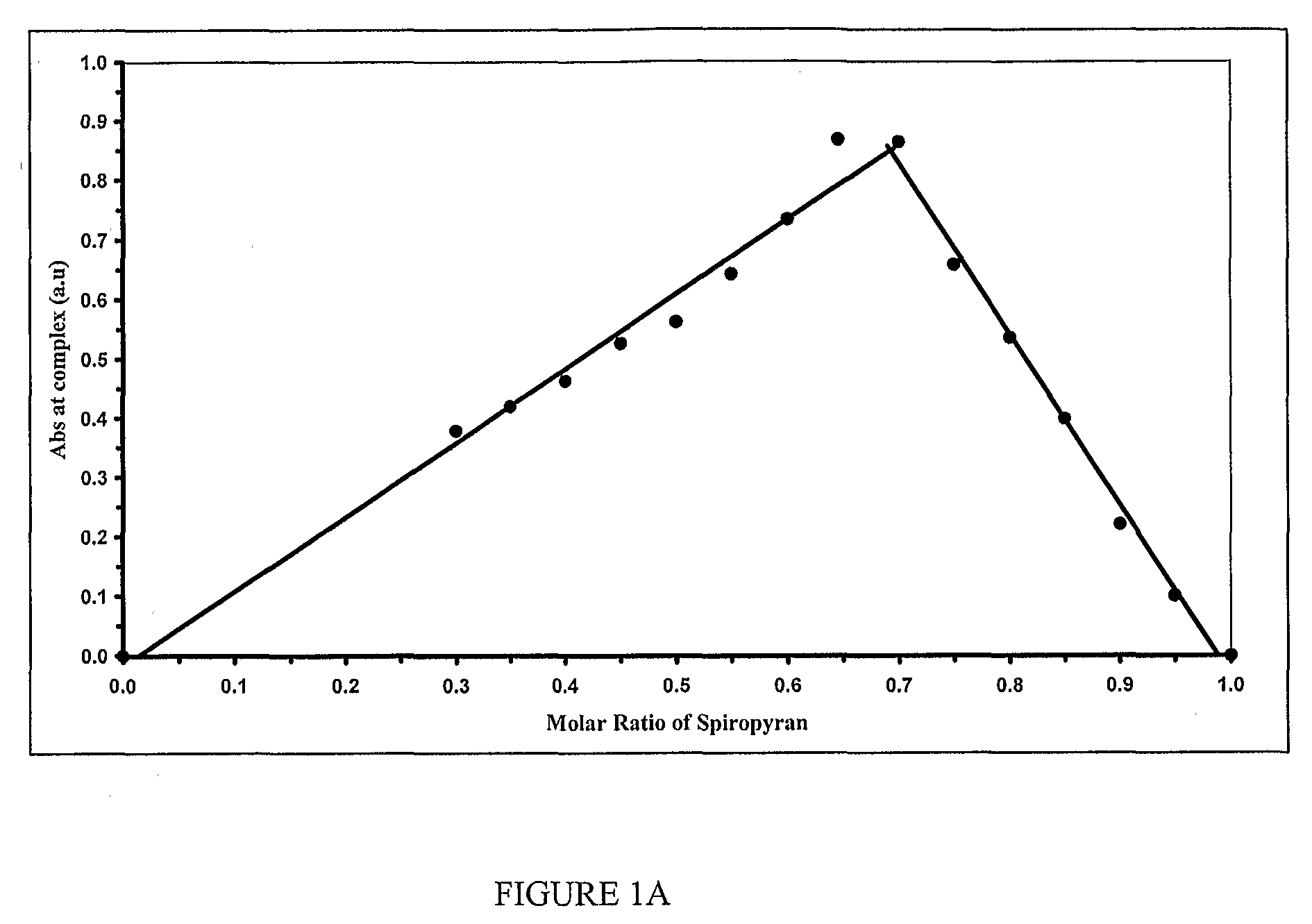Photo-Swichable Surfaces with Controllable Physico-Chemical Properties
a photo-switchable surface and controllable technology, applied in the field of chemical sensing, can solve the problems of limiting the solution phase of prior art methods, achieve the effect of facilitating the formation of a 2:1 sandwich arrangement, reducing the flexibility of surface-bound receptor molecules, and advantageously inexpensive manufacturing
- Summary
- Abstract
- Description
- Claims
- Application Information
AI Technical Summary
Benefits of technology
Problems solved by technology
Method used
Image
Examples
example i
Synthetic Make Up of Spiropyran with Carboxylic Acid Handle
[0040]In a first illustrative embodiment, a spiropyran, 1′-(3-Carboxypropyl)-3′,3′-dimethyl-6-nitrospiro[2H-1]-benzopyran-2,2′-indoline is produced in a three-step sequence beginning with the preparation of the desired indoline as the quaternary ammonium salt. The salt formation is followed by an aldol type of condensation of equimolar amounts of the quaternary salt of 1′-(3-Carbomethoxypropyl)-3′,3′-dimethyl-2-methyleneindoline and 5-nitrosalicaldyhyde to give the corresponding 1′-(3-Carbomethoxypropyl)-3′,3′-dimethyl-6-nitrospiro[2H-1]-benzopyran-2,2′-indoline. This intermediate then undergoes base-induced ester hydrolysis to give the required carboxylic acid handle on the spiropyran dye (SPCOOH).
Structure of 1′-(3-Carboxypropyl)-3′,3′-dimethyl-6-nitrospiro
[0041]
example ii
UV Photo-polymerization of Methacrylic Acid onto a PMMA Substrate
[0042]A polymethylmethacrylate (PMMA) substrate, about 0.5 mm thick, was thoroughly cleaned by immersing in about 50:50 ethanol / water solution for about 30 minutes, followed by rinsing with a large excess of deionised water. Methacrylic acid was distilled at about 50° C. under reduced pressure to remove inhibitors. The PMMA substrate was placed in a spin coating chamber and the surface covered with a monomer solution containing methacrylic acid and about 1% (w / w) of the photo-initiator omega, omega-dimethoxy-omega-phenylacetophenone, (DMPA).
[0043]The solution was allowed to absorb onto the PMMA substrate for about 5 minutes and then excess monomer was removed by spinning at about 1000 rpm for about 5 seconds. The PMMA substrate was subsequently removed from the spin coater chamber and photo-polymerization was carried out in UV curing chamber at a distance of about 10 cm from an about 280 nm UV light source for about tw...
example iii
Immobilization of Spiropyran onto Polymer Surface via 1,8 diamino octane
[0044]The PMMA-PMAA substrate, produced in Example II, was further modified as shown in the reaction scheme, set forth below for the covalent immobilization of spiropyran onto a PMAA surface via diamino alkyl groups. The PMMA-PMAA was immersed in a 1.5 mg / ml solution of 1-ethyl-3-(3-dimethylamino propyl) carbodiimide hydrochloride (EDC) in deionised water for about 20 minutes, followed by the addition of 1,8-diamino octane (7.5 mg / ml). The mixture was allowed to stir for about 24 hours at room temperature to yield an amine-terminated polymer surface (PMMA-PMAA-NH2).
[0045]The amine-coated substrate was washed in a 50:50 ethanol / water solution for 30 minutes to remove unbound 1,8-diamino octane, and then rinsed with deionised water and dried under nitrogen stream. A 3:1 solution of deionised water and ethanol containing EDC (1.5 mg / ml) and SPCOOH (2.5 mg / ml) was allowed to stir at room temperature for about 20 min...
PUM
| Property | Measurement | Unit |
|---|---|---|
| thick | aaaaa | aaaaa |
| flexibility | aaaaa | aaaaa |
| wavelength range | aaaaa | aaaaa |
Abstract
Description
Claims
Application Information
 Login to View More
Login to View More - R&D
- Intellectual Property
- Life Sciences
- Materials
- Tech Scout
- Unparalleled Data Quality
- Higher Quality Content
- 60% Fewer Hallucinations
Browse by: Latest US Patents, China's latest patents, Technical Efficacy Thesaurus, Application Domain, Technology Topic, Popular Technical Reports.
© 2025 PatSnap. All rights reserved.Legal|Privacy policy|Modern Slavery Act Transparency Statement|Sitemap|About US| Contact US: help@patsnap.com



